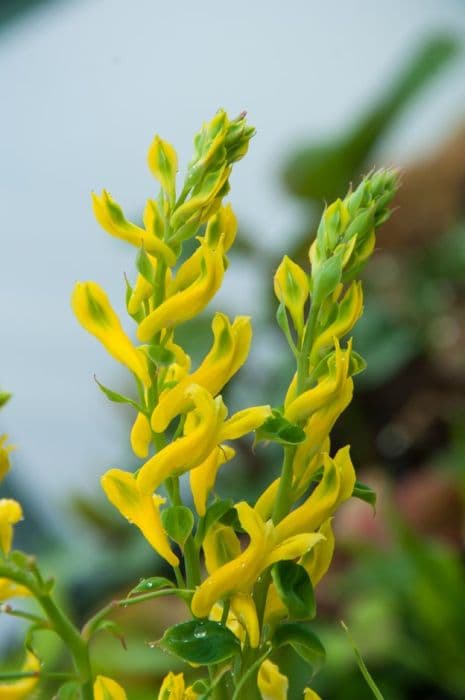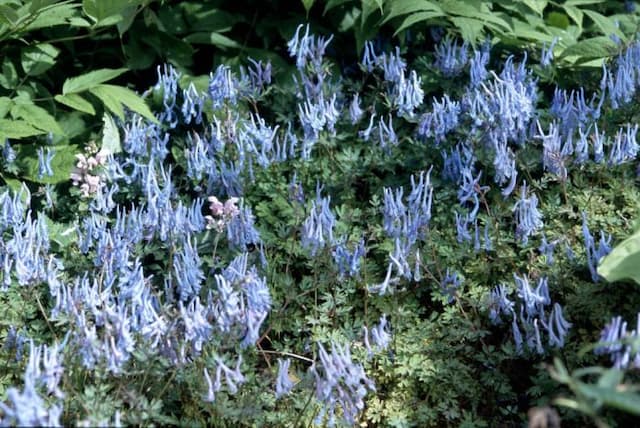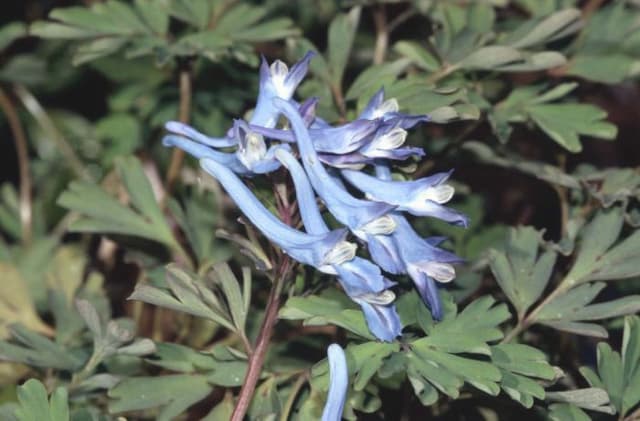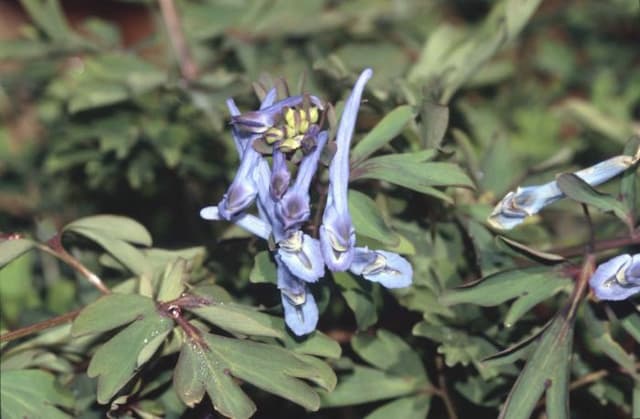Bleeding Heart Dicentra 'Pearl Drops'

ABOUT
Dicentra 'Pearl Drops' is a charming perennial plant known for its unique and attractive flowers. These blossoms are heart-shaped, with a distinctive lock-and-key appearance, an outer floral casing embracing a delicate inner petal. The color of the flowers is a soft, pearly white, giving the plant a gentle and romantic aesthetic. The foliage of Dicentra 'Pearl Drops' is also quite appealing, with fern-like leaves that are finely divided, conferring a soft, almost feathery texture to the plant. The leaves are a fresh, blue-green shade, creating a beautiful contrast against the pearl-colored flowers that dangle gracefully above them on arching stems. Overall, Dicentra 'Pearl Drops' has a mounding habit, forming clumps of lush greenery from which the flowering stems rise and nod with their delightful blooms, adding elegance and interest to garden spaces where it is planted.
About this plant
 Names
NamesFamily
Papaveraceae
Synonyms
Bleeding Heart, Dutchman's Trousers, Lady's Locket, Lyre Flower
Common names
Dicentra 'Pearl Drops'.
 Toxicity
ToxicityTo humans
The plant known as bleeding heart, of which Dicentra 'Pearl Drops' is a variety, is considered mildly toxic to humans if ingested. The toxic components are isoquinoline alkaloids, which can cause symptoms if consumed in large enough quantities. The potential symptoms of poisoning include dizziness, nausea, vomiting, diarrhea, and abdominal pain. Contact with the skin can sometimes result in dermatitis or skin irritation for sensitive individuals. It is important to avoid ingesting parts of this plant and to wash hands after handling it.
To pets
Bleeding heart is also toxic to pets, including dogs and cats. The alkaloids present in the plant can cause symptoms similar to those in humans, such as drooling, vomiting, diarrhea, and sometimes, tremors or seizures if ingested in significant amounts. It's critical to prevent pets from chewing or ingesting any part of this plant due to its toxicity and the adverse effects that can follow. If you suspect your pet has ingested bleeding heart, you should contact a veterinarian immediately.
 Characteristics
CharacteristicsLife cycle
Perennials
Foliage type
Deciduous
Color of leaves
Blue-green
Flower color
White
Height
1.5 feet (45 centimeters)
Spread
1.5 feet (45 centimeters)
Plant type
Herb
Hardiness zones
5
Native area
North America
Benefits
 General Benefits
General Benefits- Ornamental Appeal: Produces attractive pearl-like white flowers that add visual interest to gardens and landscapes.
- Low Maintenance: Requires minimal care once established, making it an ideal choice for gardeners of all skill levels.
- Hardiness: Adaptable to a variety of soil conditions and can withstand colder climates.
- Pollinator Attraction: Attracts bees, butterflies, and other beneficial pollinators, supporting local ecosystems.
- Drought Tolerance: Once established, has a degree of drought tolerance, reducing the need for frequent watering.
- Seasonal Interest: Offers a seasonal display of blooms typically in spring or summer, depending on the climate.
 Medical Properties
Medical PropertiesThis plant is not used for medical purposes.
 Air-purifying Qualities
Air-purifying QualitiesThis plant is not specifically known for air purifying qualities.
 Other Uses
Other Uses- Fairy Garden Decoration: Dicentra 'Pearl Drops', or bleeding heart, adds a whimsical touch to miniature fairy gardens due to its heart-shaped flowers and delicate foliage.
- Photography Subject: With its unique blooms, the bleeding heart is a popular subject for photographers looking to capture the beauty of nature.
- Teaching Tool: Educators can use the bleeding heart plant to demonstrate plant growth patterns, flower anatomy, and pollination to students.
- Literary Inspiration: Poets and writers may use the romantic appearance of bleeding hearts to symbolize love and emotion in their work.
- Wedding Bouquets: The elegant flowers of the bleeding heart can be included in bridal bouquets, especially for spring weddings.
- Pressed Flower Art: The distinct blooms of bleeding hearts can be pressed and used in creating botanical art and crafts due to their interesting shape and color.
- Color Inspiration: Artists and designers might draw color palette inspiration from the shades of pink and white found in bleeding heart blooms.
- Garden Themes: Bleeding hearts can be part of a 'Valentine's-themed' garden, where plants are selected for their romantic symbolism and heart-shaped features.
- Floristry Education: The bleeding heart is a good example plant for floristry students to learn about delicate and special care flowers in arrangements.
- Culinary Presentation: While not edible, bleeding heart flowers can be used as organic decorations to embellish plates and platters for food photography, taking care not to let them come in contact with the food directly.
Interesting Facts
 Feng Shui
Feng ShuiThe Bleeding Heart is not used in Feng Shui practice.
 Zodiac Sign Compitability
Zodiac Sign CompitabilityThe Bleeding Heart is not used in astrology practice.
 Plant Symbolism
Plant Symbolism- Compassion and Empathy: Dicentra, commonly known as Bleeding Heart, is often associated with compassion and empathy due to its heart-shaped flowers, which seem to express an open-hearted emotion.
- Love and Connection: The unique appearance of the Bleeding Heart's flowers, with their "droplets" at the bottom, symbolizes deep emotional connections and a strong sense of love.
- Grace and Elegance: The delicate and graceful arching stems of the Bleeding Heart are reminiscent of classic elegance and beauty.
- Rejected Love: In some cultural contexts, the Bleeding Heart can also represent the sadness of unrequited or rejected love, as the flower appears to be bleeding.
 Water
WaterBleeding heart 'Pearl Drops' should be kept consistently moist but never waterlogged. During the growing season, water the plant when the top inch of soil feels dry, which may mean watering once or twice a week depending on the weather and soil drainage. Provide the plant with about one gallon of water to ensure the soil is moistened thoroughly throughout the root zone. In hotter, drier periods, you may need to water more frequently. Reduce watering in the fall and winter when the plant is dormant, making sure the soil doesn’t completely dry out.
 Light
LightThe bleeding heart 'Pearl Drops' thrives in partial to full shade areas. It prefers a spot that is shielded from the intense afternoon sun. Morning light or dappled sunlight is ideal, providing enough brightness without the harshness of direct, strong sunlight. A north-facing garden spot or under the canopy of taller trees is often perfect for this delicate plant.
 Temperature
TemperatureThe bleeding heart 'Pearl Drops' grows best in a temperature range of 55 to 75 degrees Fahrenheit. It can survive minimum temperatures down to around 20 degrees Fahrenheit, but long exposure to such cold can be detrimental. Ideally, keep this plant in an environment that avoids the extremes, protecting it from scorching heat above 80 degrees Fahrenheit and from frost in colder climates.
 Pruning
PruningBleeding heart 'Pearl Drops' should be pruned to remove spent flowers and encourage a second bloom. Additionally, pruning can shape the plant and control its size. Cut back the foliage after it yellows and withers in the late fall to tidy the plant and prepare it for winter. Pruning is usually done annually, timed with the plant's natural dormancy cycle.
 Cleaning
CleaningAs needed
 Soil
SoilBleeding heart 'Pearl Drops' prefers fertile, well-draining soil with a pH of 6.0 to 7.0. A mix of loamy garden soil, peat moss, and perlite can create an ideal environment for healthy growth.
 Repotting
RepottingBleeding heart 'Pearl Drops' generally doesn't require frequent repotting and should be done every 3-4 years or when the plant has outgrown its current container.
 Humidity & Misting
Humidity & MistingBleeding heart 'Pearl Drops' thrives best in average humidity levels, which are typically found in most home environments, without the need for augmentation.
 Suitable locations
Suitable locationsIndoor
Place in bright, indirect light and water when the topsoil feels dry.
Outdoor
Plant in partial shade and mulch to retain moisture.
Hardiness zone
3-9 USDA
 Life cycle
Life cycleDicentra 'Pearl Drops', commonly known as Bleeding Heart 'Pearl Drops', starts its life cycle as seeds, which require a period of cold stratification to break dormancy and germinate successfully. Upon germination, the seedlings develop into juvenile plants with characteristic fern-like foliage, and given appropriate conditions of partial shade and well-draining soil, they grow and establish a root system. As the plant matures, it enters the flowering stage, typically in late spring, producing distinctive white, heart-shaped flowers that dangle from arching stems. After the blooming period, the plant sets seed, and if these seeds fall to a suitable location, they may overwinter and germinate the following spring, continuing the cycle. During the summer, as temperatures rise, the Bleeding Heart 'Pearl Drops' may enter a period of dormancy, with the foliage dying back until cooler temperatures return in the fall or the following spring. Each year, the perennial root system can send up new growth, thus repeating the cycle for several years.
 Propogation
PropogationPropogation time
Spring to summer
Propogation: The Bleeding Heart 'Pearl Drops', Dicentra 'Pearl Drops', is most commonly propagated by division, usually done in early spring or after the plant has finished flowering in late summer or early fall. To propagate by division, carefully dig up the entire plant, and using a sharp knife or spade, separate the clump into smaller sections, each with several healthy roots and shoots. Replant the divisions at the same depth they were growing previously and water well. New divisions should be spaced about 18 inches (approximately 45 centimeters) apart to allow for mature spread. It's important to keep the newly planted divisions moist until they are established and showing signs of new growth.









